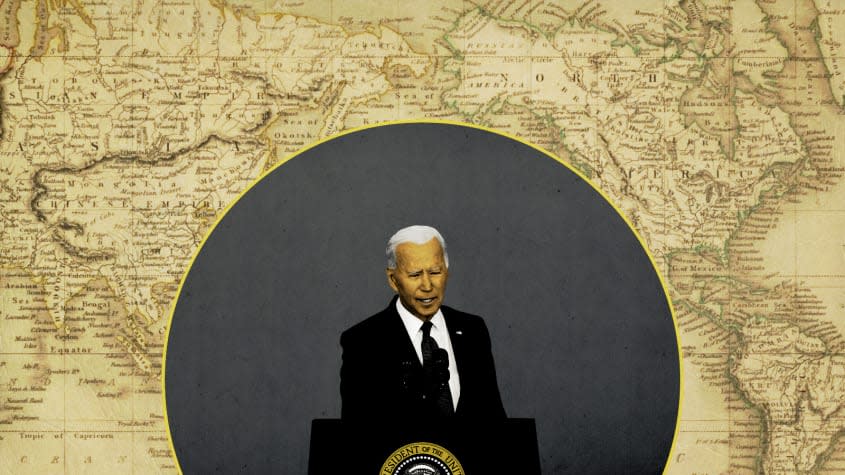What's the point of Biden's Indo-Pacific Economic Framework?

President Biden recently returned from his first presidential trip to Asia, having spent five days in Japan and South Korea meeting with leaders and assuring them the United States still has their back. Among the trip's deliverables was the Indo-Pacific Economic Framework, a China-countering proposal that's now taken center stage in the Biden administration's regional strategy. Here's everything you need to know:
What is the Indo-Pacific Economic Framework?
The IPEF is a U.S.-driven proposal intended to foster strong relationships among participating countries and "create a stronger, fairer, more resilient economy for families, workers, and businesses in the United States and in the Indo-Pacific region," the White House said. Member countries, aside from the U.S., include Australia, Brunei, India, Indonesia, Japan, South Korea, Malaysia, New Zealand, the Philippines, Singapore, Thailand, and Vietnam — though others could eventually join.
The specific details of the framework are still being negotiated, but will focus on four main policy pillars, each of which will be led by an individual U.S. agency: (1) Connected Economy, which covers higher standards and rules for digital trade; (2) Resilient Economy, which pertains to supply chain resilience; (3) Clean Economy, which targets green energy and infrastructure commitments; and (4) Fair Economy, which covers tax and corruption topics, as well as the implementation of fair trade, CNBC and the Center for Strategic & International Studies report. Countries that sign onto the framework can choose to join some or all of the four pillars, though they are "expected to commit to all aspects of each pillar they join," CSIS writes.
Overall, the framework is meant to "counter China's dominance," reaffirm lacking American influence in the Indo-Pacific region, and "establish new rules of commerce in the fastest-growing part of the world," The New York Times writes.
What is it not?
The framework is not a free trade agreement, CNBC notes, and does not include any market access or tariff reduction outlines. The IPEF is also not a security pact. The U.S., Australia, India, and Japan are notably already in such an alliance, known as the Quadrilateral Security Dialogue.
How is the IPEF different from other agreements?
On a formatting level, the IPEF is an executive agreement and will not require congressional approval like a traditional trade agreement would, CSIS notes.
Otherwise, for the U.S., the framework "effectively replaces" the larger Trans-Pacific Partnership agreement negotiated under former President Barack Obama but abandoned by his successor, Donald Trump. Rather than just rejoining the TPP (which later became the Comprehensive and Progressive Agreement for Trans-Pacific Partnership), however, Biden opted for this new proposal, which notably arrives not long after the China-led "Regional Comprehensive Economic Partnership officially went into force, linking 15 Asia-Pacific economies in the world's largest trade bloc," the Times writes.
At the moment, writes Bloomberg, there's "not enough known yet about the IPEF to judge how it will ultimately compare" to the RCEP.
What do critics say?
Some lawmakers have complained that the IPEF lacks the teeth to actually make an impact, and is "more symbolic than it is effective or real policy," CNBC writes. Its lack of tariff reduction and open market provisions has also proven a sore spot, per Voice of America.
"The good news is, the U.S. is engaging actively in commerce in Asia and using its convening power to bring these 12 important economies together, now the bad news is, there really is no teeth in this," David Adelman, former U.S. ambassador to Singapore, told CNBC on Tuesday.
"If you look at the four pillars, it's really asking the partners to do something to change their laws or regulations or the way they operate," added international trade expert Bryan Mercurio. "I think what the U.S. has to offer, and the only thing the U.S. has to offer, is money."
"But of course," Mercurio went on, "what Asian partners really want is trade. I think they want market access. And the trade component of the IPEF is really lacking."
What's China's' take?
Per CBS News, the Chinese government has said IPEF threatens to create exclusivity that could possibly beget turmoil in the region. Chinese Foreign Minister Wang Yi has also criticized the effort as "doomed to fail," per Bloomberg.
Why isn't Taiwan included?
Speaking of China, the U.S. is "hedging against potential blowback from Beijing" by leaving Taiwan out of the IPEF, at least for the time being, writes The Diplomat. Many of the Indo-Pacific nations participating in the framework would rather not anger their powerful neighbor, and the U.S. knows that. "Thus, including Taiwan in the first round of countries participating in IPEF could have embroiled the U.S. in a controversy over Taiwan's representation, and the U.S. would not want the focus of the framework to be overshadowed," The Diplomat writes. Further to that, there's also the issue of what name the U.S. would allow Taiwan to use.
It is still possible Taiwan joins down the line.
What's next?
In the coming months, countries that showed interest in joining the IPEF will be expected to select the pillars under which they'd like to enter negotiations, CSIS reports. Then, by mid-summer, "the administration aims to convene a ministerial summit with all countries that participated in the launch event to scope the overall negotiations, break into groups by pillar, and begin negotiations." The White House hopes to conclude those negotiations within 12 to 18 months, then finalize IPEF agreements by The Asia-Pacific Economic Cooperation (APEC) Leaders' Meeting in November 2023.
You may also like
Are Russia's gains in eastern Ukraine turning the tide of its war?
CDC identifies 9 monkeypox cases across 7 states
Jury begins deliberations in Johnny Depp-Amber Heard libel trial

